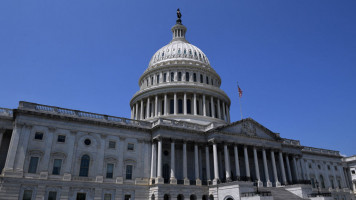"The test of the Hoveizeh cruise missile was carried out successfully at a range of 1,200 kilometres (840 miles) and accurately hit the set target," Defence Minister Amir Hatami said, quoted on state television which broadcast footage of its launch.
"It can be ready in the shortest possible time and flies at a very low altitude," he said.
Hatami described the Hoveizeh as the "long arm of the Islamic Republic of Iran" in defending itself.
It is part of the Soumar group of cruise missiles, first unveiled in 2015 with a range of 700 kilometres, according to the minister.
The Hoveizeh unveiling was part of an arms exhibition dubbed "40 years of defensive achievements" and held in Tehran.
Friday marked the beginning of ten days of celebrations of the Islamic Revolution that ousted the pro-Western shah.
On Thursday, thousands of Iranians had packed the mausoleum of the Islamic republic's founder Ayatollah Ruhollah Khomeini.
Iran has voluntarily limited the range of its missiles to 2,000 kilometres (1,250 miles), but this is still sufficient to reach Israel and Western bases in the Middle East.
Washington and its allies have accused Tehran of pursuing enhanced missile capabilities that also threaten Europe.
Iran has "no intention of increasing the range" of its missiles, the country's Supreme National Security Council Secretary, Admiral Ali Shamkhani, said on Tuesday.
|
 |
Washington and its allies have accused Tehran of pursuing enhanced missile capabilities that also threaten Europe |
 |
|
'Purely defensive'
Iran reined in most of its nuclear programme under a landmark 2015 deal with major powers but has kept up development of its ballistic missile technology.
US President Donald Trump's administration pulled out of the nuclear accord in May and reimposed sanctions against Iran, citing the missile programme among its reasons.
European governments have stuck by the 2015 agreement, although some have demanded an addition to address Iran's ballistic missile programme and its intervention in regional conflicts including Yemen.
UN Security Council Resolution 2231 - adopted just after the nuclear deal - calls on Iran "not to undertake any activity related to ballistic missiles designed to be capable of delivering nuclear weapons".
The US has repeatedly accused Iran of violating the resolution.
But Tehran denies seeking any nuclear weapons capability, and insists that its missile development programme is "purely defensive" and compliant with the resolution.
Iran's space programme has also been criticised by the West, with Washington charging that an abortive satellite launch in mid-January was cover for a bid to develop an intercontinental ballistic missile capability.
Iran tried unsuccessfully to put a satellite into orbit on 15 January and plans to "vigorously carry on" and make a second attempt, Shamkhani said.
Iran's newly-tested missile takes its name from a city in the southwestern province of Khuzestan that was devastated in the 1980-1988 war against Saddam Hussein's Iraq.
Several Iranian cities were battered by missiles during the eight-year conflict in a bombing campaign dubbed the "war of the cities".
Iranian officials say Western sanctions have starved its air force of spare parts and replacement aircraft, limiting its operational capacity and forcing it to rely on the missile programme.
As Iranians marked the anniversary of the revolution, the US on Saturday lashed out at the country's leadership, insisting it had failed to make good on pledges to improve the lives of ordinary people.
"When he returned to Iran in 1979, Ayatollah Khomeini made lots of promises to the Iranian people, including justice, freedom, and prosperity," the US State Department said on Twitter.
"40 years later, Iran's ruling regime has broken all those promises."



![Palestinians mourned the victims of an Israeli strike on Deir al-Balah [Getty]](/sites/default/files/styles/image_684x385/public/2024-11/GettyImages-2182362043.jpg?h=199d8c1f&itok=xSHZFbmc)


![The law could be enforced against teachers without prior notice [Getty]](/sites/default/files/styles/image_684x385/public/2178740715.jpeg?h=a5f2f23a&itok=hnqrCS4x)
 Follow the Middle East's top stories in English at The New Arab on Google News
Follow the Middle East's top stories in English at The New Arab on Google News


